 |
World History
Thy Will Be Done,
on Earth as It Is In Heaven
Luiz Siqueira Campos
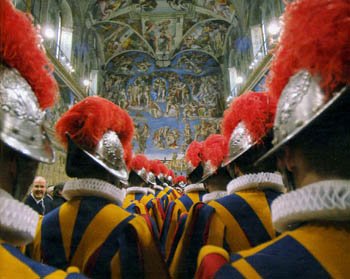
The Swiss Guard celebrates 500 years of glorious history in 2006 - Point de Vue, February 1, 2006
|
Everyone has heard something about the Papal Swiss Guard. This year - the year of its 500th anniversary - it is, more than ever, easy to find material on it. Invited to comment on this venerable Catholic institution, I offer the reader some considerations regarding its significance past and present.
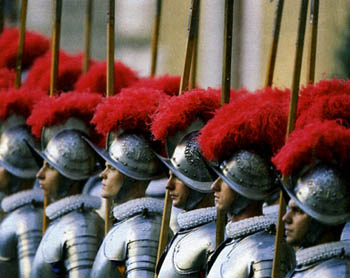
The Swiss Guard symbolizes the power of the Pope in the temporal sphere
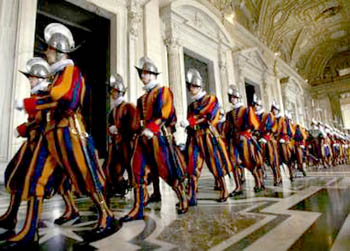
|
What principles are concealed under the magnificent colorful uniforms of this heroic guard? There are several very important ones.
This vibrant unit represents, first, the right the Church has to defend her territory; second and consequently, it speaks of the Church's right to have her own territories. Third, the institution of Swiss Guard also supposes that the Church should have temporal states.
The Swiss Guard is not the only symbol of these rights. The silver key on the papal coat-of-arms symbolizes that the Pope should rule the temporal sphere indirectly. At the same time, he should rule the spiritual sphere directly, a power represented by the gold key.
Even in our liberal world, there are not many Catholics who dare to contest the Pope's spiritual authority, represented by the golden key. Since Vatican Council II, however, there has been much contestation of the Holy Church's right to have territories or intervene in temporal affairs.
So, the importance of this living relic of the Catholic armies of times past - the only official military corps of the Papacy that still survives - is to affirm the right of the Church to have territories and to be a sovereign nation in the temporal sphere.
This also means that Catholics have the right to defend themselves using force in accordance with the law. Jesus Christ is the Prince of Peace - there is no doubt about this truth - but when peace is endangered or God's will cannot be executed, there should be a military power ready to enforce the Divine Law.
The splendor of truth
Catholic Philosophy teaches us that beauty is the splendor of truth and goodness. In a certain way this applies to the Swiss Guard.
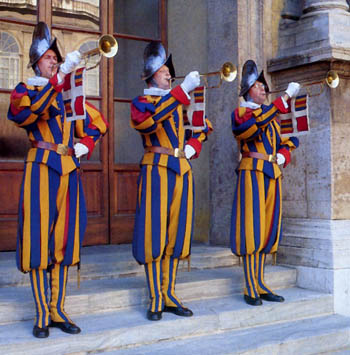
The external beauty of the uniforms reflect the moral qualities of the Swiss soldier |
The Swiss Guard is undoubtedly a picturesque institution, with their vibrant multi-colored uniforms and banners, and their shining armor and weapons. It is also one of the last remaining symbols that link us to the beautiful institutions of the Middle Ages. Although the uniforms were actually designed by Michelangelo under the order of Pope Julius II - and therefore in the Renaissance - the attire retained many traits that characterized a medieval corps of soldiers. The spirit of Switzerland at that time was still that of the Middle Ages.
This external beauty in fact reflected the moral qualities of the authentic Swiss soldier - loyalty, discipline, and dependability in times of peace as well as war, both at home and on foreign soil. It was these qualities that made them the most sought-after bodyguards, to whom sovereigns trusted their lives and their family's honor for many centuries. The trustworthiness of the Swiss soldier has been fully demonstrated on many occasions in the last revolutionary centuries. For example, they were the last loyal defenders of King Louis XVI of France before he was taken by the revolutionaries. The faithful company of Swiss soldiers offered their lives to save the King's in the bloody episodes of the French Revolution.
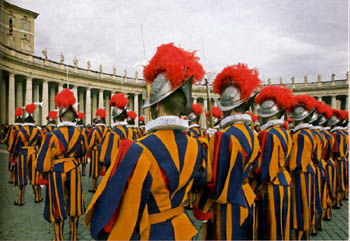
The red they wear symbolizes the blood they should willingly shed to defend the Pope |
One can sustain that the blue, yellow and red dress-uniform with its pleated collar, white gloves and silver metal helmet with ostrich-feather plumes could well be the most beautiful ever made. But it is even more glorious for those few who know that the vivid red background of the uniform was not always dye, but at times the warm, generously spilled blood that flowed from the vein of these loyal soldiers.
In fact, the red symbolizes the blood they should willingly shed in defense of the Pope in accordance with their oath:
"I swear to faithfully, honestly and honorably serve the reigning Pope [name of Pope] and his legitimate successors, and to dedicate myself to them with all my strength, ready to sacrifice, should it become necessary, even my own life for them."
The splendor of goodness
And what about goodness? In philosophy, "goodness" is the quality according to which a thing or a person accomplishes his duty, realizes what he was made to do.
For 500 years, since they were founded by Pope Julius II on January, 22, 1506, the Papal Swiss Guards have shown that they were able to defend the Holy See, especially the person who occupies the Throne of Saint Peter. One of the most heroic pages in their history was written during the sack of Rome by the troops of Charles V in the 16th century. I transcribe an excerpt from a description of their heroic defense:
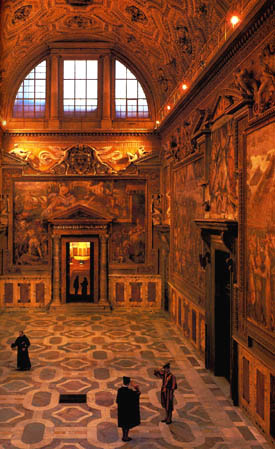
Changing of the guard in the antechamber to the Sistine and Pauline Chapels |
"On the morning of May 6th, 1527, from his headquarters set up at St. Onofrio's Convent on the Gianicolo hill, Commander General Bourbon launched a series of attacks on Rome.... The Swiss Guard, standing firm at the foot of the obelisk [now in St. Peter's Square, but then near the German cemetery passing the Vatican's gate, at the left of the Columns of Bernini], together with the few remnants of the Roman troops, resisted desperately. Their Captain, Kaspar Röist was wounded, and later killed by the Spaniards in his quarters in front of his wife, Elizabeth Klingler. Of the 189 Swiss Guards, only 42 survived, the ones who, when all was lost, under the command of Hercules Göldli guarded Clement VII's retreat to safety in Castel Sant'Angelo. The rest fell gloriously, massacred together with 200 fugitives, on the steps of the High Altar in St. Peter's Basilica ...
"Across the Sisto Bridge the lansquenets and Spaniards fell on the city and for eight days committed every sort of violence, theft, sacrilege and massacre, even the tombs of the Popes were violated in search of spoils. There were as many as 12,000 dead and the booty amounted to ten million ducats. All that happened cannot really be regarded with surprise because the imperial army and in particular Frundsberg's lansquenets, were animated by a violent spirit against the Pope.
"In front of Castel Sant'Angelo where the Pope had retreated, a parody of a religious procession was set up, in which Clement was asked to cede the sails and oars of the Navicella [boat of Peter] to Luther, and the angry soldiery shouted "Vivat Lutherus pontifex!" ("Swiss Guard History" on The Vatican website)
The Swiss Guard accomplished its duty then, and continues to do so to this day. Thus it fulfils the splendor of the goal for which was created, which adds to its moral beauty.
The future of the Swiss Guard
What will be the future of the Swiss Guard?
I am afraid that the future of the Swiss Guard is in danger. Not by any military enemy, but rather by the danger of Pacifism, so characteristic of the Progressivist mentality, which unfortunately dominates the Church today. Indeed, two other military corps of the Vatican have already been abolished by this mentality.
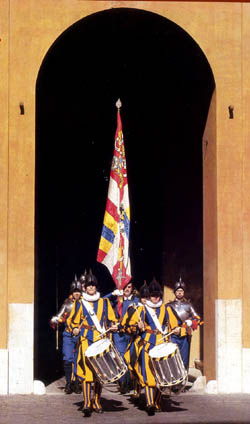
The Swiss Guard - the last of the pontifical military units |
I am referring to the Noble Guard and the Palatine Guard.
The Noble Guard, founded by the Pope Pius VII in 1801 as a regiment of heavy cavalry, was made up exclusively of members of the Roman Patriciate and Nobility who gave personal escort and security for the Pope, as well as providing other needs. This elite guard, which later became a corps of foot guards, was volunteer, each member considering it a high honor to serve and protect the Supreme Pontiff in public as well as private.
The Palatine Guard, an infantry unit founded by Pope Pius IX in 1850, took part in watch-keeping in Rome as well as various battles defending the city. It played an important role in the defense of Rome against the combined troops of Garibaldi and Victor Emmanuel that took over the Pontifical States and all the papal properties in Rome, leaving only the Vatican for the Pope.
These two glorious military corps were abolished in 1970 by Pope Paul VI as part of the "reforms" following Vatican II. As far as I can understand, there was no reason to do away with these noble institutions other than they constituted active, symbolic manifestations of the militancy of the Church.
The Swiss Guard is the last survival of the weapon-bearing military units of the Vatican that represent the Militant Church.
We pray in the Our Father: Thy Will be done, on Earth as it is in Heaven. What does it mean to carry out God's will on earth?
I think that the will of God should be favored by the Law and civil authorities. Further, it should be executed by means of force, if necessary. History is filled with examples of individuals and peoples who took up arms to accomplish God's will in both the Old and New Covenants. The same principle applies regarding the Vicar of Christ on earth, the Sovereign Pontiff. His will should be done in his domains by persuasion or by force. It is an imperative of Natural Law; it is also a precept of Divine Law. The Swiss Guards remind us of these truths.
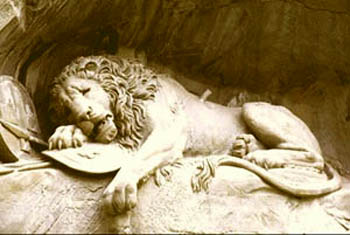
Monument in Lucerne, Switzerland, to the Swiss Guards who fell in the French Revolution |

Posted on July 24, 2006

Related Topics of Interest
 Is the Catholic Church Still a Monarchy Is the Catholic Church Still a Monarchy
 St. Peter and Vatican Exhibit: Marvelous Continuity and Shocking Change St. Peter and Vatican Exhibit: Marvelous Continuity and Shocking Change
 The Appeal of the Stones at San Juan Capistrano The Appeal of the Stones at San Juan Capistrano
 The crisis of the Church and the Message of Fatima The crisis of the Church and the Message of Fatima
 The Immaculate Character of the Catholic Church The Immaculate Character of the Catholic Church

|
History | Home | Books | CDs | Search | Contact Us | Donate

© 2002- Tradition in Action, Inc. All Rights Reserved
|
 |
|